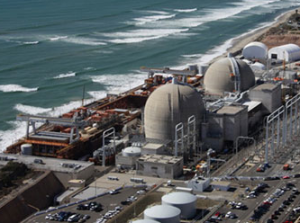An anti-nuclear advocacy group demanded indefinitely suspending Southern California Edison’s license to operate San Onofre’s nuclear generators at a hearing Wednesday unless the utility receives federal regulatory approval to restart the plant.
In a formal hearing before the federal Nuclear Regulatory Agency, spokesmen for Friends of the Earth claimed that Edison illegally breached its obligation to seek federal approval to amend its license before making changes at the San Onofre Nuclear Generating Station and that those changes led to a “near miss” radioactive gas leak and a complete shut-down of the plant a year ago.
Edison recently revealed plans to restart one of San Onofre’s two nuclear power generators at 70 percent capacity for a trial period of five months. Reopening the plant will commence upon completion of NRC’s current safety inspection, said a spokesman for Edison, which earlier this month asked federal regulators to deny FOE’s claims, stating that no “significant” new information or issues are being raised that have not already been evaluated and approved by the NRC.
Since the early 1980s, steam generator replacements have been made without a license amendment, except where technical changes were needed, said Maureen Brown, an SCE spokesperson by email.
FOE attorney Richard Ayres said in this week’s hearing that the plant should be indefinitely closed until or if NRC approval on past changes is received. FOE consultant Arnie Gundersen testified that the utility’s replacement steam generators were installed not only without NRC scrutiny but also without the required public input and prior to engineering analysis for safety.
Rather than “like for like” changes, which would not require NRC approval or public knowledge, Gundersen claimed that Edison instead added equipment, including a four percent increase in radioactive gas-carrying tubes. These, he claimed, ultimately resulted in intensified heat at the center of the generator, eventual tube wear and a potentially catastrophic toxic gas leak that threatened millions of residents within its radius.
“It was a near miss,” said Gundersen. “Nobody has screwed up worse than San Onofre.”
An Edison representative at the hearing said that the company had no questions for FOE.
In his presentation, Gundersen compared mishaps at San Onofre to procedural “like for like” changes made at the Palo Verde Nuclear Generating Station, which followed the license amendment process when 10 percent more tubes were added, power was increased by 2.9 percent and NRC approval was sought and received.
One tube leaked at San Onofre and both generators were shut down last February. Eight tubes later failed in a follow-up pressure test, according to reports. If the eight tubes had “popped” while the plant was under power, Gundersen said in a later telephone interview, a major disaster could have occurred. “We’re not just talking about evacuating San Clemente,” he said, “we’re talking about a much more significant radiation release.” Instead of a 10-mile radius evacuation, Gundersen estimated that a 30- to 50-mile evacuation radius would have been required. “In the last 10 years, this has been by far the worst mechanical failure in a (U.S.) nuclear power plant,” he said.
Ayres said FOE will oppose the restarting of the plant and will have a formal response within two weeks. Edison is expected to respond to FOE’s latest protest to the NRC’s Atomic Safety and Licensing Board on Jan. 30. NRC representatives said the commission will decide within the next few weeks whether Edison needs further approval before restarting San Onofre.
Response to the teleconference hearing on Wednesday exceeded the NRC’s initial capacity for open phone lines. A new service with unlimited access was set up and nearly 100 callers were on the lines, according to an unofficial tally.
“There is absolutely no question,” Dan Hirsch, president of the nuclear safety organization Committee to Bridge the Gap in Vermont, said during the hearing, “that the change made by Edison with this new design led to more than a minor increase in the likelihood of malfunction because, in fact, it did malfunction. It seems to me that the question you are asking has been empirically demonstrated by a billion-dollar steam generator project collapsing.”
When asked by an NRC representative why a license amendment would be required before anyone was aware of a problem, Ayres said Edison should have known better by analyzing the situation thoroughly. “They have the responsibility to do that,” Ayres said. “For them to say, ‘Oh well, we didn’t understand that because we didn’t look at it,’ is not fulfilling the obligation they have to understand the effects of the changes they’re making to the plant.”
Gundersen claimed that Edison knew there were design “distortions” in metal support bars from Japanese manufacturer Mitsubishi Heavy Industries. The distortions, he said, led to unusual rubbing and caused tubes that carry extremely hot radioactive water and gas to leak. He said that problem became evident when Edison later changed the tube design to avoid the distortion for the second nuclear power unit.
“The adverse condition was known to Edison before these were ever operated,” Gundersen said, adding that seeking approval after the generators were already operating is counterproductive. “This missile’s been fired and it’s on a ballistic trajectory at this point.” He added that Mitsubishi should not become the “scape goat” in the fray over who’s responsible.





